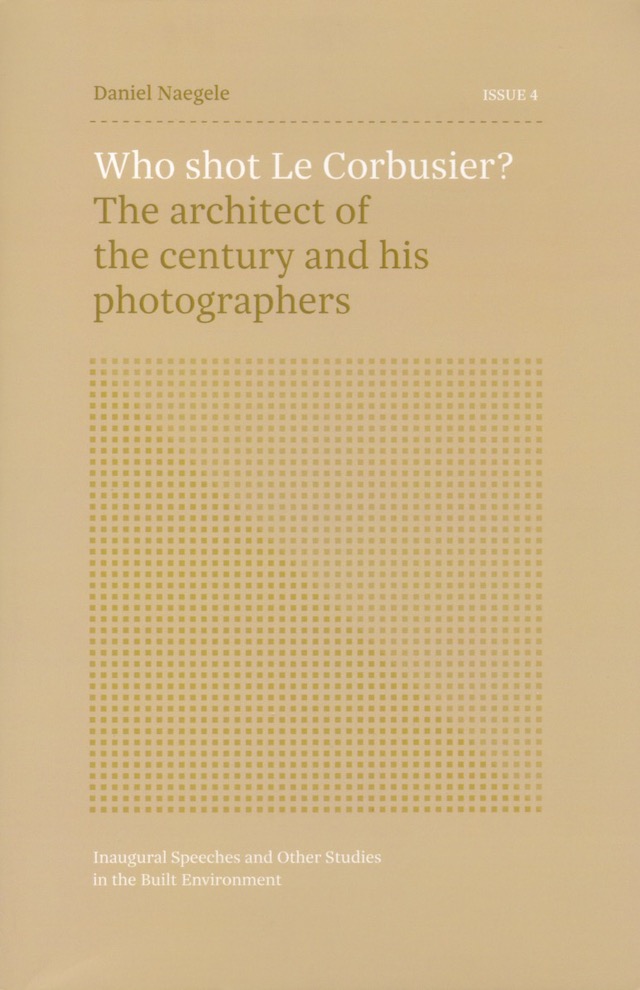Who Shot Le Corbusier?
Who shot Le Corbusier? The architect of the century and his photographersDaniel NaegeleTU Delft Open, August 2020Paperback | 5-1/4 x 8 inches | 148 pages | 52 illustrations | English | ISBN: 978-9463663083PUBLISHER'S DESCRIPTION: Who were Le Corbusier’s photographers? The question is seldom asked yet is germane to understanding the architect’s work. Le Corbusier used photography to promote modern architecture in ways no others did. He directed the photography of his buildings, selected the images that he liked, cropped them, abstracted them, and placed them on the pages of his many books. He mediated the medium of photography manipulating visual facts in an era when “the camera never lied”. Yet always he began with images that others provided him. Photographers and advancing photo-technology were essential and when they changed, his imagery changed, and between 1922 and 1965 both changed often. Once a craft practiced by skilled technicians with large-format cameras and glass plate negatives, by the mid-1930s, architectural photography had become an art that could be executed by amateurs with hand-held cameras, faster films, and superb lenses. This altered the nature of the photograph and subsequently Le Corbusier’s understanding of his endeavor. For him, photography never simply documented a completed building, it created a new one. He saw through photography. Daniel Naegele is an architect and associate professor of architecture at Iowa State University. A graduate of Yale University and of the Architectural Association in London, he completed his dissertation, Le Corbusier's Seeing Things: Ambiguity and Illusion in the Representation of Modern Architecture, under the supervision of Joseph Rykwert at the University of Pennsylvania in 1996. dDAB COMMENTARY: On page 88 of Daniel Naegele's book-length expansion of a chapter from his 25-year-old dissertation on Le Corbusier, he quotes a letter from Atelier Le Corbusier addressed to "gentlemen photographers" that was written in 1953 but still echoes today. The architect contends that the artistic rights reside with him, not the photographers, since he "designed the buildings [...] built the buildings [...] and often wrote or provoked the news articles under consideration." Furthermore, Le Corbusier referred to photographers as "technicians" who would take direction from the architect (his cousin, Pierre Jeanneret, would scout photos for that purpose) and would make their living from publications demanding photos of Le Corbusier's buildings. In other words, the more success Le Corbusier gained, the more he expected what amounted to free work, passing the responsibility on to others. He certainly would have been home in today's economy, with businesses asking writers, photographers, and other freelancers to "donate" their work in exchange for "exposure." By the time readers get to the page described above, these tactics Le Corbusier employed and his perspective toward photographers are hardly surprising, since Naegele has described in detail some of the transactions between the architect and those "who shot Le Corbusier." Basically, Le Corbusier did not hire photographers for most of his career, he rarely credited them in his books, and given his views on artists rights he expected photographs to be given to him. The last, which often involved multiple copies of each image snapped by a photographer, was so cost prohibitive that one photographer described it like paying an employee only enough to cover their transit to and from work. Le Corbusier believed that his buildings created the photographs more than the photographer did — something I learned in Naegele's illuminating book that is available as an open-access PDF — so his tactics are not entirely alarming. But going in, I equated the importance of photography in Le Corbusier's many books as a sign of respect, only to learn that roughly the opposite was true. One photographer who Le Corbusier appreciated, and who even became something of a "house photographer" for the architect, was Lucien Hervé. He shot the bulk of images in The Chapel at Ronchamp, the second Les carnets de la recherche patiente book put out by Le Corbusier (one I'm familiar with), and maintained a working relationship with the architect from 1948 to the latter's death in 1965. Still, this didn't mean Le Corbusier simply paid Hervé to go shoot his buildings; rather, when a magazine or museum called Atelier Le Corbusier, the architect recommended Hervé or dispatched him to go take photos. Hervé's relationship with Le Corbusier basically comprises the last part of the book, starting a couple pages after page 88. Although he was Le Corbusier's go-to photographer, it wasn't all sunny. For example, Hervé's images of Chandigarh from 1962 were "insufficient," arising more from circumstances, though, than the photographer's talent. Whatever the case, those photos illustrate how Le Corbusier's control over the presentation of his work trum

TU Delft Open, August 2020
Paperback | 5-1/4 x 8 inches | 148 pages | 52 illustrations | English | ISBN: 978-9463663083
PUBLISHER'S DESCRIPTION:
SPREADS:






